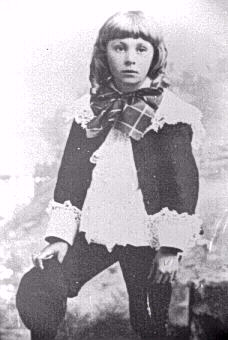
Figure 1.--This older boy wears an elaborate Fauntleroy blouse with a large collar made of eyelet lace. He also has a colorfuk plaid bow to complete his outfit. |

|
Many boys' outfits had collars which could be worn with or without bows. The bow not being an integral element of the outfit. Often it was up to the mother's disgression as to add a bow or not. Other styles required large floppy bows. As the century progressed open
collars disappeared and collars were increasingly worn with bows--in some cases very large floppy bows. The Fauntleroy suit was commonly worn with a large collar, often with a suitably large floppy bow added. Some smaller bows were also worn, but many mothers chose the larger size. Hre we will discuss some of the different collar styles commnly worn with bows.
Many Fauntleroy blouses had very large collars, sometimes covering the entire shoulder area of the velvet jackets. Most were made with eyelet lace or ruffles which could be used to greatly enlarge the size of the collar. Not all the collars were elaborate lace or ruffled. Some were quite plain. The
more fashionable Fautleroy suits, however, did have elaborate lace or latter ruffles. Some mothers elected not to add a bow to an elegant lace collar so as not to distract from it. Other mothers much preferred to add a large decorative bow so many lace Fautleroy
collars were worn with bows. This was generally up to the mother's discresion rather than the design of the blouse. Colors varied, but were usually black or white. The black bows contrasted nicely with the emaculate white lace collars, matching the black velvet suit. They appear to be the most common, but details on color is not readuly available as so much of the information comes from black and white photographs. Many Fautleroy suits were made in other dark colored velvet, such as blue, green, and burgandy. I'm not sure what colored bows were worn with these colored suits. Some mothers, however, preferred the elegant white-on-white look of white bows on white collars. The boys might wear a red sash with there Fauntleroy suit, but never a red bow. Scotch plaid bows, however, were worn.
We do not yet have a page specifically about bows on Buster Boown collars, but we do have some information on Buster Brown suits. The large white collars of Buster Brown suits
were normally worn with large floppy bows. Buster Brown suits are the boy's style most associated with large floppy bows. These suits were particularly popular around the turn of the century. The bows were of different colors, usually black or dark blue, but unlike the bows worn with Fauntleroy suits sometimes red.
Eton collars like lace and ruffled collars could be worn without bows. We note large numbers of portraits showing boys wearing Eton collars both with nd without bows. We also notice boys weaing Eton collars with many other types of neckwear. Often younger boys would wear lace collars or ruffled collars andcthen switch to Eton collars as they got a little older. This night vary widely chronologically and at th disgression of the boy's mother. We have noted quite young boys wearing Eton collrs. These younger boys usually wore their Eton collars with floppy bows, but we have noted boys as old as 10 or even older also wearing floppy bows with their Eton collars.
We do not yet have a page specifically about bows on middy blouses, but we do have some information on middy blouses. The classic middy blouses, both white and blue, were worn with small black or dark blue kerchiefs knotted at the front. The large floppy bows worn with Fauntleroy suits and Buster Brown suits were not worn with the classic style of middy blouses. There were, however, many different styles of sailor suits, some quite fanciful. Some of these has quite large bows.
We note boys wearing very small collars during the mid-19th century. Some were so small that they were virtually unobservavle over the jackets. Others or a little larger and can better be made out. They were done in various styles. We see both pointed and rounded collars as well as ruffled collars. They stand in sharp contrast to the large collars worn in the late-19th century. Boys did not often wear bows with these small collars. A good example is Elisha Dickerman, an American boy about 1850.
Navigate the Boys' Historical Clothing Web Site:
[Return to the Main collar bow page]
[Introduction]
[Activities]
[Biographies]
[Chronology]
[Clothing styles]
[Countries]
[Bibliographies]
[Contributions]
[Essays]
[FAQs]
[Glossaries]
[Satellites]
[Tools]
[Boys' Clothing Home]
